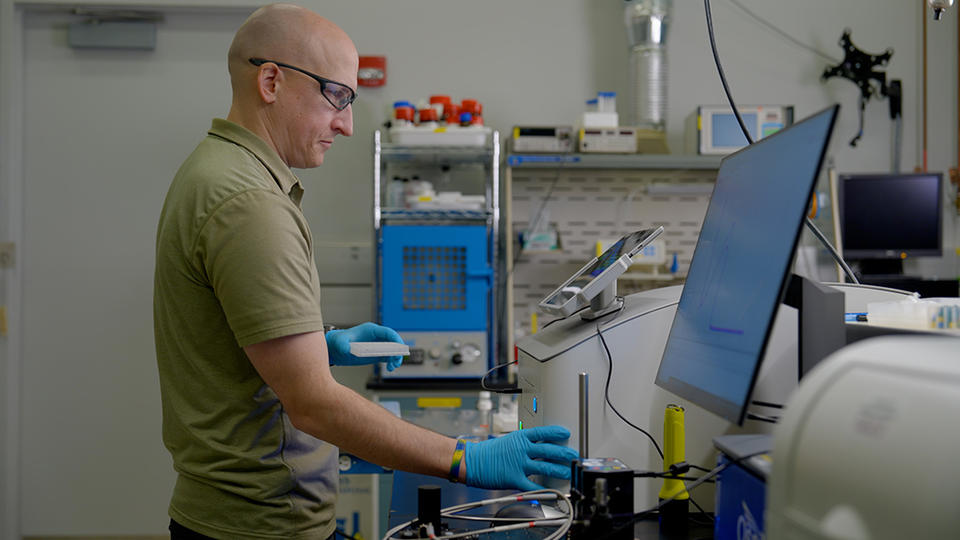
Your Future Medications Could Be Personalized for You on a 3D Printer

NIST researcher Thomas P. Forbes is working to ensure 3D drug printers work as designed.
Credit: R. Eskalis/NIST
Chocolate-flavored pills for children who hate taking medicine.
Several drugs combined into one daily pill for seniors who have trouble remembering to take their medications.
Drugs printed at your local pharmacy at personalized dosages that best suit your health needs.
These are just a few potential advantages of 3D drug printing, a new system for manufacturing drugs and treatments on-site at pharmacies, health care facilities and other remote locations.
In 2015, the Food and Drug Administration approved the first 3D-printed drug, Spritam (levetiracetam), for epilepsy. Several other manufacturers and drug companies are developing their own ones.
But the widespread adoption of 3D drug printing will require stringent quality control measures to ensure that people get the right medication and dosage. Even a tiny mismeasurement of a drug’s ingredient during the printing process could endanger a patient’s health.
In a new research paper, NIST research scientist Thomas P. Forbes assesses various approaches to ensuring that 3D drug printers work as designed. The journal article applies a “quality by design” analysis to evaluate the best procedures and protocols to ensure that 3D printers produce drugs at the correct dosages and with the correct mix of chemicals.
The 3D Drug Printing Process
Though various methods exist for remotely printing drugs, Forbes focused on one of the most common: inkjet printers and similar systems that can print personalized medication on demand.
Like inkjet printers in homes, though larger, the printer has nozzles that deposit the drug’s liquified materials, or inks, into tiny wells on a tray or directly into capsules. Through freeze-drying and other processes, the liquid can be turned into a tablet or powder poured into a capsule. It can also be evaporated onto a thin film that dissolves in the mouth.
Forbes’ paper does not make any recommendations. Instead, his research identifies and tests several possible methods and techniques for maintaining quality control in 3D drug printing.
The Taking Measure blog spoke with Forbes about his research.
What are some of the advantages of 3D drug printing?
Credit: R. Eskalis/NIST
When your doctor writes a prescription, she knows drugs are available in certain dosages, and she’ll choose the dosage she thinks is best for you. Some drugs come in many sizes, while others come in just one.
3D printing enables you to individualize the dosage. You can do it based on the person's age, health, even their immune system or genetic profile.
You can also personalize the form that the medicine takes. Some patients may prefer a liquid to a capsule, for example. There’s also been research on polypills, which combine multiple pills into a single drug. And some scientists have focused on the benefits for children who don’t like to take their medicine. With 3D printing, you can create drugs shaped like starfishes or ones that taste like chocolate.
3D drug printing also has the huge potential to change vaccine distribution.
Yes, there’s a lot of interest in providing “point-of-care” locations where the vaccines would be printed near where they’re administered.
You’d still have a larger facility making the raw materials, but you could be much more agile and quicker in getting the vaccine to the public. This would be hugely helpful during another pandemic.
Your research focuses on quality control and measurements in 3D drug printing.
Yes, we will need to know that these 3D printers are working correctly. They need to print the correct dosages with the right ingredients. So, we will need on-site methods of taking and validating measurements. This is an area where NIST has a great deal of expertise.
In your journal article, you break down the quality control process step by step. Can you take us through that?
Credit: R. Eskalis/NIST
It starts with the delivery of the printing ink to the remote location. You need to confirm it hasn’t degraded, evaporated or been exposed to unusual temperatures. You want to confirm it’s still good.
We used a technique called ultraviolet-visible (UV-Vis) spectroscopy. There are now relatively inexpensive tabletop and even handheld UV-Vis spectrometers on the market. They work by shining ultraviolet and visible light through your sample. How the sample absorbs them tells you about its chemical composition.
Next, we looked at how you can verify your printer is working correctly. Many commercial printers have LEDs beneath the individual nozzles that print the ink for the drugs. Every time the nozzle releases a drop of ink, it breaks the flow of light, which is detected by a type of light detector known as a photodiode.
The photodiode will detect if the nozzle stops releasing liquid because you’ve run out of ink. If there’s a blockage in the nozzle or even a piece of dust causing irregularities in the flow of ink drops, that will also be detected. In our tests, we found the LEDs and photodiodes performed well.
What about confirming that you’ve printed the correct amount of the drug?
That’s tricky. You need a nondestructive way of confirming the correct dosage. We are working on this right now. It’s the next big step.
What’s the ultimate goal here?
We’d like to produce a series of voluntary protocols or recommendations for quality control and measurement accuracy in 3D drug printing. We will likely work collaboratively with other groups, such as American Society for Testing and Materials or United States Pharmacopeia, to release these.
If 3D drug printing becomes widely adopted, we want to be ready to support both industry and regulatory agencies with a measurement science foundation.
EIN Presswire does not exercise editorial control over third-party content provided, uploaded, published, or distributed by users of EIN Presswire. We are a distributor, not a publisher, of 3rd party content. Such content may contain the views, opinions, statements, offers, and other material of the respective users, suppliers, participants, or authors.

